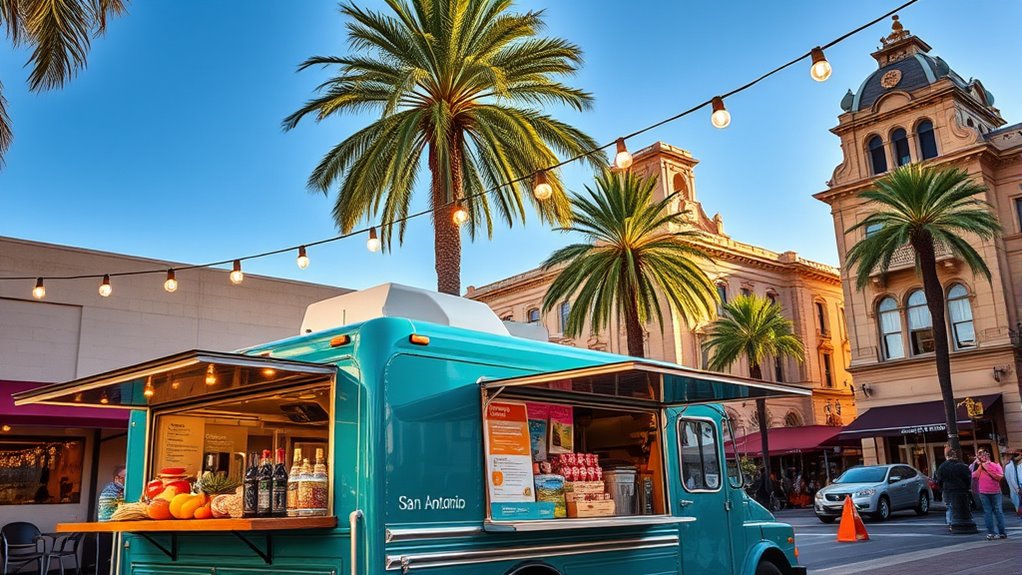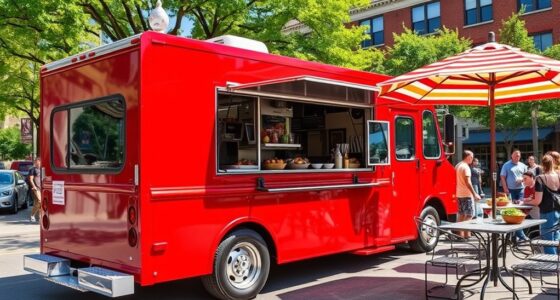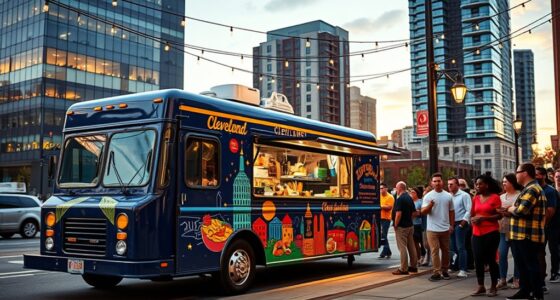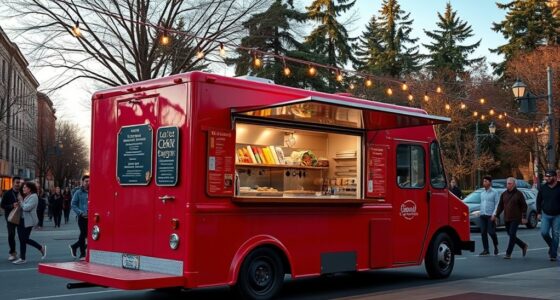To start a food truck in San Antonio, TX, first research local permits from the health department, register with the state, and guarantee your vehicle meets safety standards. Secure financing through savings, loans, or investors, and plan your menu focusing on local flavors. Build a strong brand and engage with the community through social media and local events. If you keep exploring, you’ll discover how to navigate regulations and build a thriving business.
Key Takeaways
- Research local permits, health regulations, and zoning laws specific to San Antonio, TX, to ensure legal operation.
- Secure startup capital through savings, loans, grants, or crowdfunding, and develop a detailed business plan.
- Design your menu with local ingredients and price competitively to attract and retain customers.
- Obtain liability insurance, register your business, and set up efficient payment and inventory management systems.
- Engage with the community and participate in local events to build brand recognition and foster customer loyalty.
Starting a Food Truck Journey
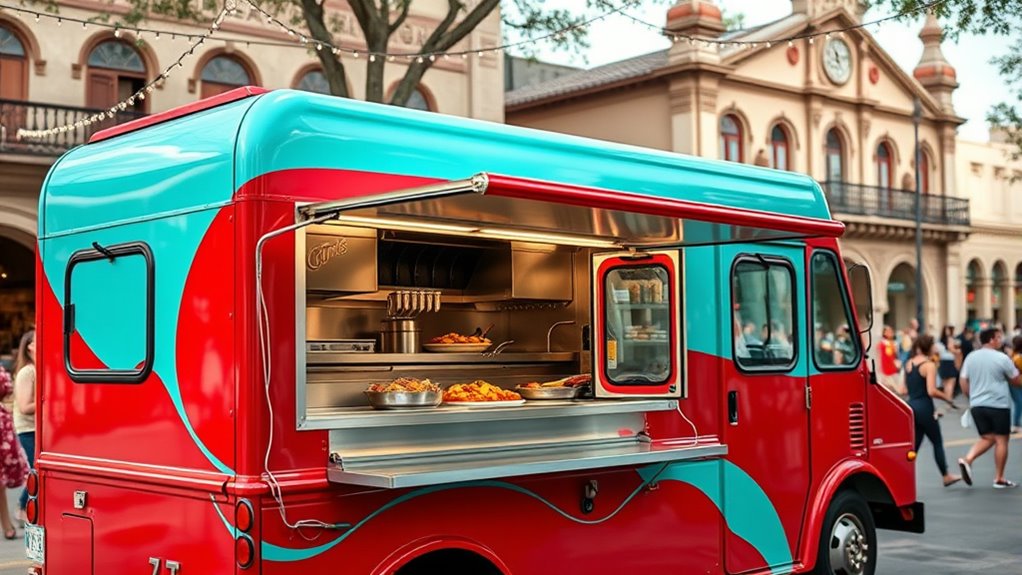
Starting a food truck journey can be an exciting venture, but it requires careful planning and preparation. Your first step is creating strong food truck branding that sets you apart and attracts your target audience. Consistent branding helps customers recognize your truck easily and builds familiarity. Focus on memorable visuals, a catchy name, and a clear message that reflects your cuisine. Building customer loyalty is key to long-term success, so prioritize excellent service and quality food. Engage with your community through social media and special promotions to keep your customers coming back. Remember, a well-branded and customer-focused approach can turn casual visitors into loyal fans, fueling your growth and reputation in San Antonio’s vibrant food scene. Incorporating brand consistency across all touchpoints can further strengthen your identity and customer trust.
Understanding Local Requirements
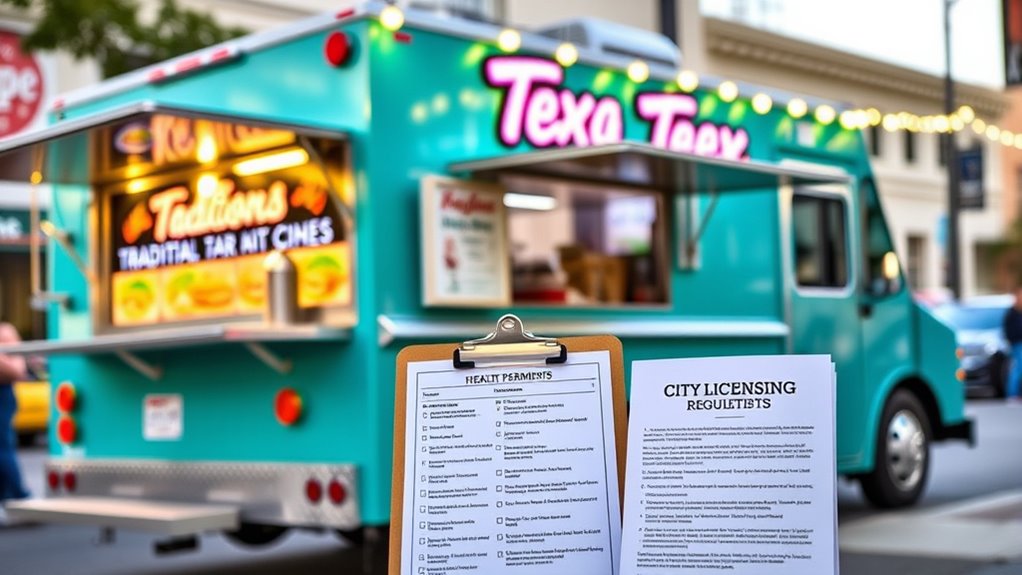
To operate a food truck in San Antonio, you need to understand the permit application process and meet health inspection standards. You should also be aware of designated street parking zones to avoid violations. Staying informed about these requirements helps guarantee a smooth launch and ongoing compliance. Additionally, familiarize yourself with local regulations that might impact your operation, such as zoning laws and special licensing requirements.
San Antonio Permit Application Process
Getting your food truck approved to operate in San Antonio requires understanding the city’s specific permit application process. Start by applying for necessary food truck permits and ensuring your business complies with san antonio licensing requirements. The process involves submitting detailed documents and paying applicable fees, which vary based on your truck’s size and location. To help navigate this, review the following table:
| Requirement | Details |
|---|---|
| Food truck permits | Obtain from San Antonio Metro Health Department |
| Business registration | Register with the Texas Secretary of State |
| Vehicle compliance | Pass safety and emissions inspections |
| Location approval | Secure zoning and street permits |
| Fees | Vary depending on permit and truck size |
Completing these steps guarantees your food truck is legally ready to serve in San Antonio.
San Antonio Health Inspection Checklist
Before you can operate your food truck in San Antonio, you need to pass a health inspection that guarantees compliance with local safety standards. The San Antonio health inspection checklist covers essential areas to ensure food safety and adherence to health regulations. You’ll need to demonstrate proper food handling, storage, and sanitation practices. Inspectors will check that your equipment is clean, maintained, and functioning correctly. They’ll also review your pest control measures, employee hygiene, and waste disposal methods. Make sure your menu items are prepared using safe techniques, and your water supply is potable. Staying up-to-date with local health regulations helps prevent violations and delays. Preparing thoroughly for the inspection ensures your food truck meets all San Antonio health standards and is ready to serve safely.
Designated Street Parking Zones
Understanding the designated street parking zones in San Antonio is essential for legally operating your food truck. Knowing where you can park helps you avoid fines and guarantees compliance with local rules. Street parking regulations specify which zones allow food trucks and the hours of operation, making zone enforcement clearer. It’s vital to familiarize yourself with posted signs and markings to prevent violations. Some zones are reserved for specific uses or times, so double-check before parking. Additionally, stay updated on any temporary restrictions or changes in parking policies. Properly understanding these zones helps you plan your routes and locations efficiently. By respecting designated street parking zones, you’ll maintain good standing with city authorities and ensure smooth daily operations for your food truck.
Setting Up Your Base of Operations
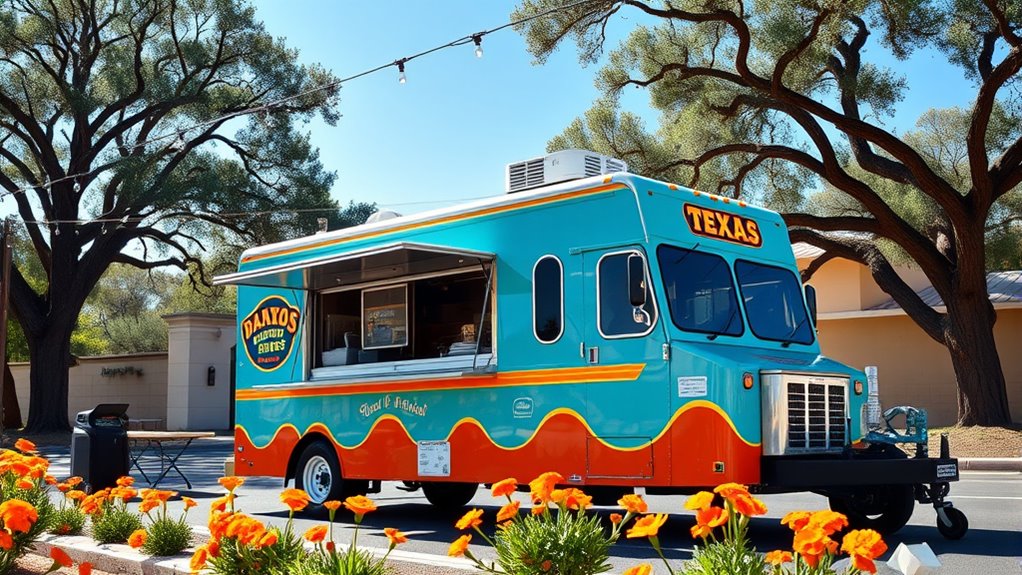
Setting up your base of operations means ensuring you meet shared kitchen licensing requirements and install the right custom kitchen appliances. You need to choose a compliant space that fits your needs and adheres to local regulations. Getting this setup right keeps your food truck running smoothly and legally. Understanding trust issues in partnerships can help you establish clear agreements and maintain a reliable operation.
Shared Kitchen Licensing Requirements
Establishing your food truck’s base of operations requires obtaining the appropriate shared kitchen license, which guarantees your business complies with health and safety regulations. This shared kitchen licensing guarantees you meet all licensing compliance standards set by local authorities. To get started, you’ll need to:
- Complete an application for a shared kitchen permit
- Pass health inspections demonstrating cleanliness and safety
- Provide proof of food safety training
- Maintain proper storage and sanitation standards
Custom Kitchen Appliances Installation
Once you’ve secured your shared kitchen license, the next step is installing custom kitchen appliances that suit your food truck’s menu and workflow. Custom kitchen appliance installation guarantees your setup is efficient and tailored to your cooking style. Focus on selecting appliances that meet your specific needs, such as commercial-grade stoves, fryers, or refrigeration units. Proper installation is critical for safety and functionality, so consider hiring professionals experienced in custom kitchen setups for food trucks. They’ll ensure everything fits within your limited space while complying with local health and safety regulations. With the right appliance installation, your food truck will operate smoothly, allowing you to serve fresh, quality food quickly. This step sets the foundation for a successful and efficient mobile kitchen.
Budgeting and Financing Your Food Truck
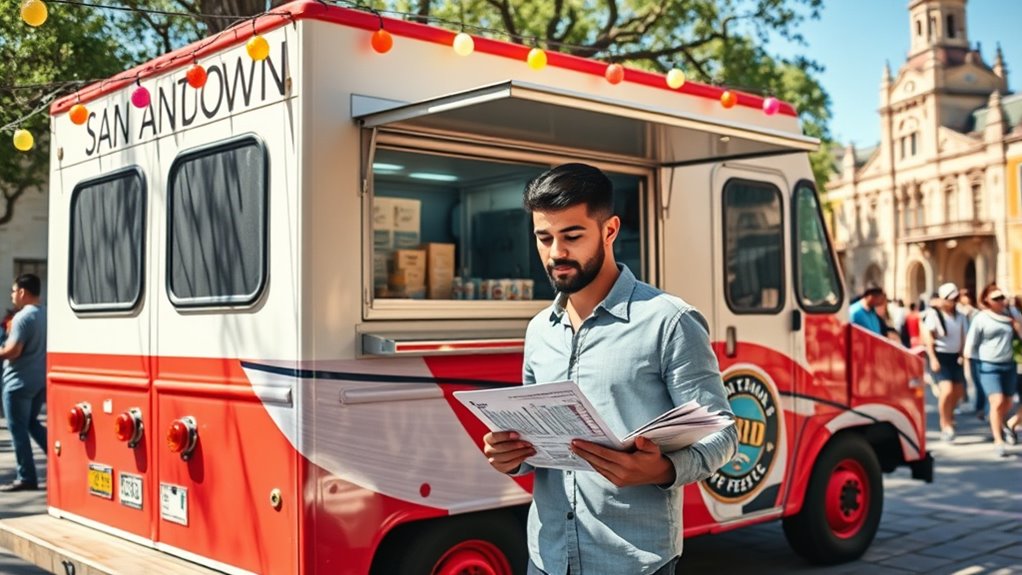
To get your food truck rolling, you’ll need to budget for initial equipment costs and identify startup capital sources. It’s also essential to plan for liability insurance and understand your tax filing obligations. Being clear on these points will help you secure funds and set a solid financial foundation. Considering for sale 100 items can also be an option to acquire affordable equipment or supplies within your budget.
Initial Equipment Purchase Costs
Expect to spend between $20,000 and $100,000 on initial equipment when launching your food truck, depending on the size and complexity of your setup. Your costs will vary based on factors like custom kitchen costs and whether you choose to buy outright or opt for equipment leasing.
- Custom kitchen costs can markedly impact your budget, especially if you need specialized appliances or layouts.
- Equipment leasing offers a way to reduce upfront expenses, providing flexibility as your business grows.
- Essential equipment includes cooking appliances, refrigeration, sinks, and serving stations.
- High-quality, durable tools ensure efficiency and longevity, saving you money in the long run.
Careful planning here helps you balance quality and cost, setting a strong foundation for your food truck.
Startup Capital Sources for Food Trucks
Securing the right startup capital is essential to launching your food truck successfully. You can explore various sources like personal savings, bank loans, or investor funding to cover costs such as equipment, permits, and initial inventory. Some entrepreneurs consider small business grants or crowdfunding platforms to raise additional funds. Remember, a strong focus on food truck branding from the start helps attract customers and build loyalty. Well-funded marketing efforts, including social media and local promotions, can set you apart in San Antonio’s competitive scene. By carefully budgeting and obtaining diverse financing options, you’ll be better prepared to sustain operations and grow your customer base. Ultimately, solid financial planning ensures you can deliver quality food and excellent service to foster customer loyalty.
Liability Insurance and Tax Filing
Understanding liability insurance and tax filing is essential for budgeting and financing your food truck. Liability coverage protects you from potential lawsuits, ensuring your business stays afloat if accidents happen. Staying on top of tax deadlines helps you avoid penalties and keeps your finances in order. To manage this effectively, consider these key points:
- Select appropriate liability coverage tailored to food truck operations
- Keep detailed records of income and expenses for accurate tax filing
- Be aware of tax deadlines to submit your returns on time
- Consult a tax professional to optimize deductions and ensure compliance
Designing Your Menu and Pricing Strategy
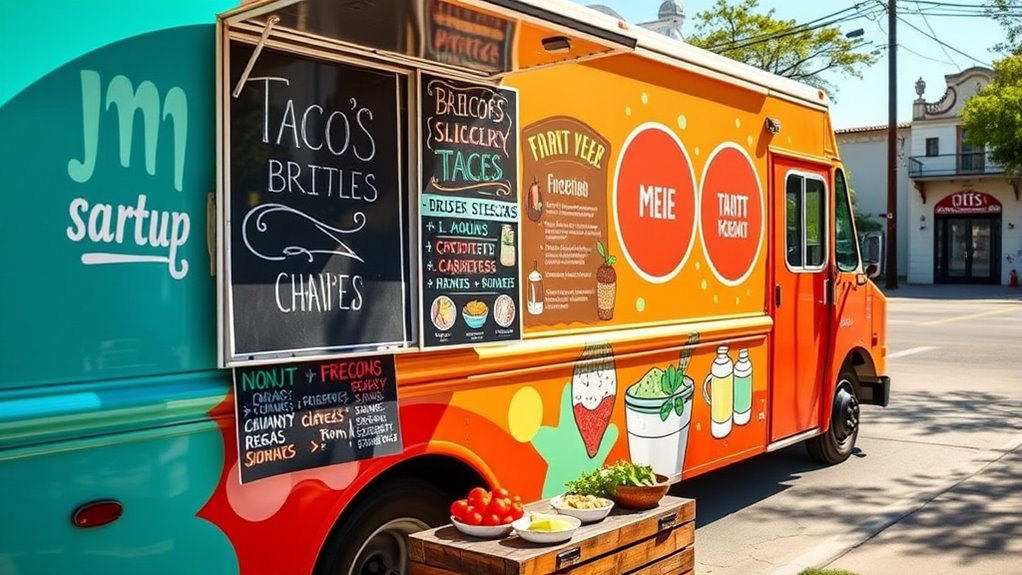
When designing your menu, focus on incorporating local ingredients to appeal to your community and stand out. Break down your costs carefully to set prices that cover expenses while offering value to your customers. Balancing quality, cost, and customer satisfaction is key to building a successful pricing strategy. Additionally, consider how your offerings can reflect the artistic influence of local culinary traditions, creating a unique experience that resonates with your customers.
Crafting Dishes With Local Ingredients
Designing your menu and pricing strategy around local ingredients is essential for creating authentic and appealing dishes that resonate with your community. When you prioritize local ingredients, you enhance dish craftsmanship and showcase regional flavors. This approach not only supports local farmers but also adds freshness and uniqueness to your offerings.
- Source seasonal produce and meats to ensure quality and flavor
- Highlight local ingredients in your menu descriptions to attract customers
- Experiment with regional recipes to emphasize local culinary traditions
- Price dishes competitively while reflecting the value of fresh, local ingredients
Cost Breakdown and Customer Value
Creating a balanced menu and pricing strategy requires carefully analyzing your costs to guarantee profitability while providing value to customers. Conduct a thorough cost analysis to understand ingredient expenses, labor, and overheads. This helps you set prices that cover costs and generate profit without overcharging. Keep customer satisfaction in mind by offering dishes that are flavorful and reasonably priced. A well-designed menu balances variety and affordability, ensuring customers see value in each purchase. Regularly review your costs and adjust prices if necessary to maintain margins. Transparent pricing and quality ingredients build trust and loyalty. Ultimately, combining detailed cost analysis with a focus on customer satisfaction ensures your food truck remains profitable while delivering an excellent experience.
Technology and Operations
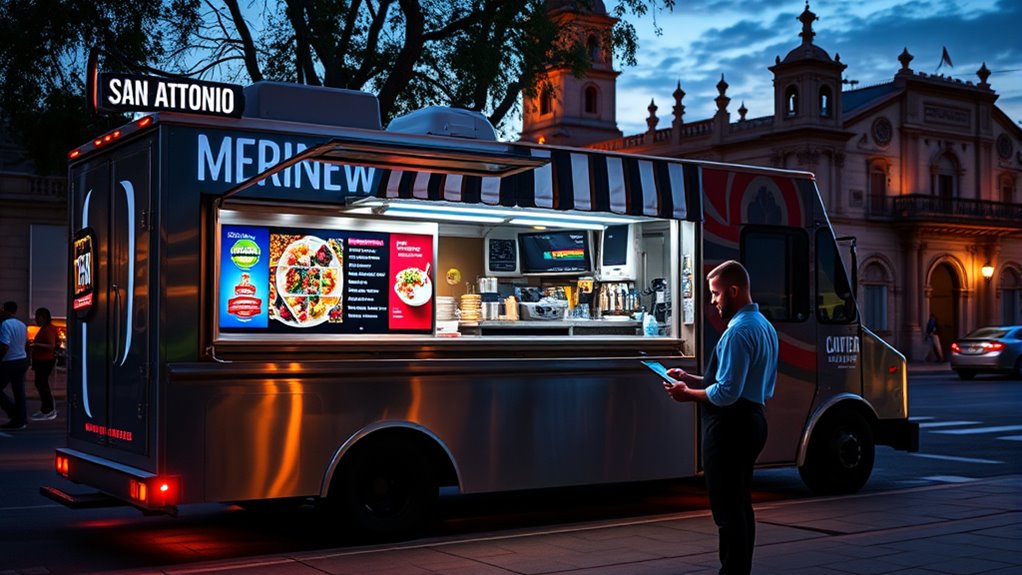
Integrating mobile payment apps makes transactions quick and easy for your customers. Using real-time stock tracking software helps you manage inventory efficiently and avoid shortages. These tools streamline your operations, so you can focus on serving great food and growing your business.
Mobile Payment App Integration
Implementing a mobile payment app is essential for streamlining transactions and enhancing customer convenience at your food truck. It allows for quick, secure cashless payments, improving the overall experience. With a mobile POS system, you can process payments swiftly and reduce wait times. Consider these key points:
- Accept various forms of cashless payments like credit cards, digital wallets, and QR codes
- Integrate seamlessly with your existing POS system for smooth operations
- Guarantee secure transaction processing to protect customer data
- Provide receipts via email or text to improve transparency and record-keeping
Real-time Stock Tracking Software
To keep your food truck running smoothly and meet customer demand, real-time stock tracking software plays a vital role. It enhances inventory management by providing instant updates on ingredient levels, so you know exactly when to reorder. With effective order tracking, you can monitor each sale and stock movement, reducing waste and preventing shortages. This technology allows you to quickly identify popular items and adjust inventory accordingly, keeping your menu fresh and profitable. By automating stock updates, you spend less time manually counting supplies and more time focusing on customer service. Overall, real-time stock tracking software streamlines operations, minimizes errors, and guarantees you always have the right ingredients on hand, helping your food truck stay efficient and competitive on the busy streets of San Antonio.
Marketing and Growing Your Presence
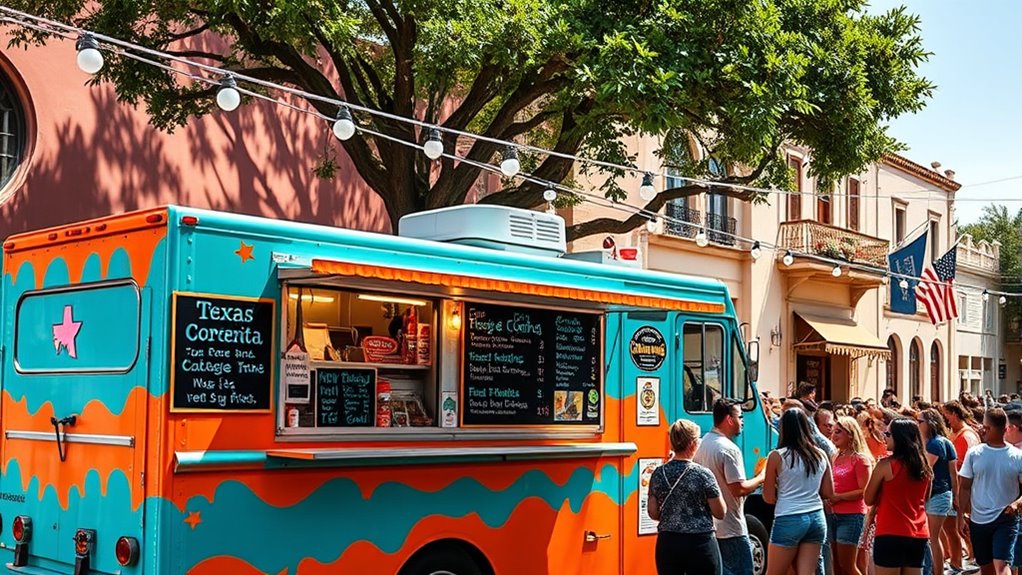
To grow your food truck’s presence, you should focus on popular local event locations where crowds gather. Engaging Instagram Stories can boost your promotions and keep customers excited about your offerings. Combining these strategies helps you connect with the community and attract more loyal fans.
Popular Local Event Locations
Choosing the right event locations can markedly boost your food truck’s visibility and attract new customers in San Antonio. To maximize your reach, focus on popular local event locations that draw diverse crowds. These venues are perfect for enhancing your food truck branding and building a loyal customer base. When planning your schedule, consider events like farmers’ markets, music festivals, sports games, and community fairs. Attending these events helps you connect with different demographics and showcase your menu. Effective local event planning guarantees you’re in the right place at the right time, increasing sales and visibility. Remember, consistency is key—attend recurring events to build recognition and trust within the community. Picking the right spots can turn casual passersby into loyal customers.
Engaging Instagram Stories for Promotions
Instagram Stories offer a dynamic way to promote your food truck and grow your presence in San Antonio. They boost Instagram engagement and help drive traffic to your location. Use Stories to showcase daily specials, behind-the-scenes moments, or customer reactions. Incorporate polls, questions, and countdowns to encourage interaction and make your audience feel involved. Effective Story promotion keeps followers engaged and enthusiastic for updates. Consider this table to maximize impact:
| Content Type | Goal | Best Practice |
|---|---|---|
| Behind-the-scenes | Build authenticity | Share prep and truck life |
| Promotions | Drive sales | Announce discounts or events |
| Customer stories | Increase trust | Feature happy customers |
Consistent, engaging Stories foster stronger community ties and elevate your brand in San Antonio.
Navigating San Antonio’s Food Scene
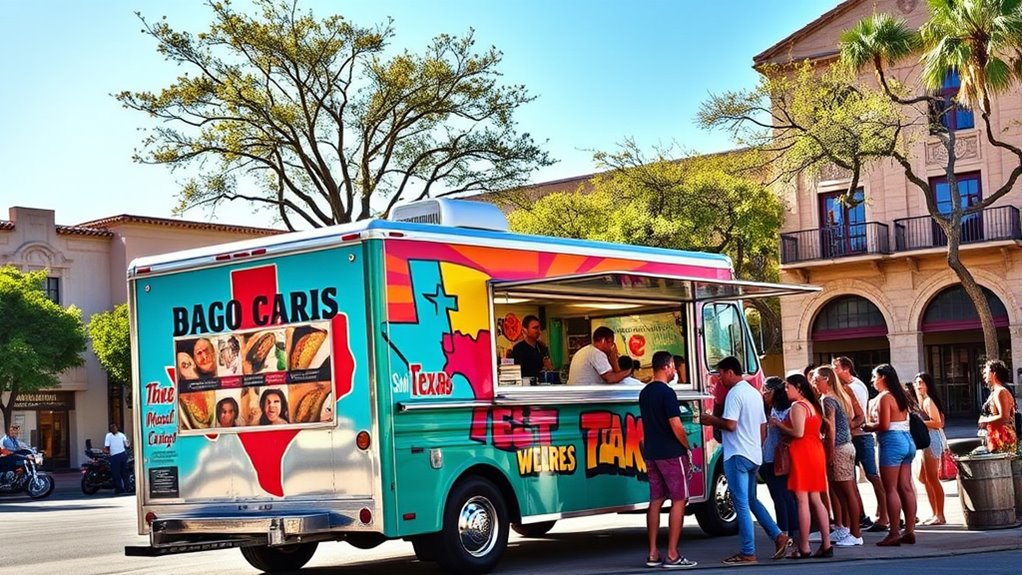
Exploring San Antonio’s vibrant food scene can be an exciting adventure, especially with the city’s diverse culinary options spread across bustling streets and hidden neighborhoods. To navigate this landscape, immerse yourself in local food festivals, which showcase regional flavors and connect you with fellow food enthusiasts. Attend culinary collaborations where chefs team up, offering unique dishes that can inspire your own menu ideas.
You’ll also want to explore neighborhood hotspots, from historic districts to emerging food hubs. Keep an eye on social media and community boards for pop-up events and chef-led tastings. These experiences help you understand local tastes and trends, essential for positioning your food truck successfully. Embracing San Antonio’s dynamic food scene will give you insight, connections, and inspiration to thrive.
Frequently Asked Questions
What Permits Are Required for Street Vending in San Antonio?
You need to obtain food truck permits and follow vending regulations to operate legally in San Antonio. Start by applying for a mobile food vendor permit from the San Antonio Metropolitan Health District, which involves passing health inspections. You’ll also need a City of San Antonio vending permit and possibly a special event permit if you plan to vend at festivals. Make sure to check local zoning laws to avoid any issues with street vending.
How Can I Find the Best Locations for My Food Truck?
You need to hit the ground running and find the best spots for your food truck. Focus on location scouting by exploring busy areas, parks, and near offices or events. Conduct foot traffic analysis to gauge customer flow and peak times. Talk to local business owners and check out popular spots during different times of day. Remember, the right location can turn your truck into a local favorite before you know it.
Are There Specific Health Codes I Need to Follow?
You need to follow San Antonio’s health codes to guarantee food safety and pass health inspections. This includes maintaining proper food handling, storage, and sanitation standards, and obtaining necessary permits. Regularly inspect your truck’s cleanliness, keep documentation updated, and stay current with local regulations. By doing so, you’ll ensure compliance, protect your customers, and avoid costly fines or shutdowns during health inspections.
What Insurance Coverage Is Recommended for Food Truck Owners?
You should consider thorough insurance options like general liability, vehicle insurance, and workers’ compensation to protect your food truck business. Make sure your coverage requirements include protection against accidents, property damage, and food-related liabilities. It’s wise to consult with an insurance agent familiar with local regulations to customize your policy. Having the right coverage ensures you’re financially protected and compliant with San Antonio’s health and safety standards.
How Can I Build a Loyal Customer Base Quickly?
You can build a loyal customer base quickly by leveraging social media strategies and customer loyalty programs. Did you know that 74% of consumers rely on social media to make dining decisions? Use platforms like Instagram and Facebook to showcase your menu and location updates. Implement loyalty programs that reward repeat customers, encouraging them to return often. Engaging with your community online and rewarding loyalty helps create a dedicated customer base fast.
Conclusion
Starting your food truck in San Antonio might seem overwhelming, but with the right planning, you can turn your culinary dreams into reality. Don’t let permits or startup costs hold you back—many successful owners started just like you. Focus on your unique menu and community connections, and you’ll stand out in this vibrant food scene. Take that first step today, and watch your food truck become a beloved part of San Antonio’s lively culture.
